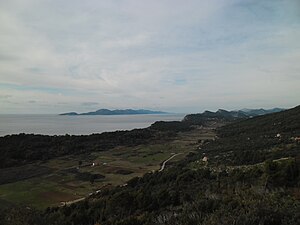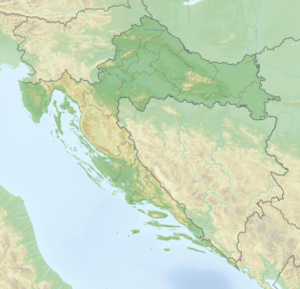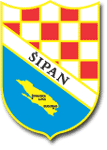Sipan
| Sipan | ||
|---|---|---|
| Šipan (in the background) | ||
| Waters | the Adrian Sea | |
| Archipelago | Elaphites | |
| Geographical location | 42 ° 43 '41 " N , 17 ° 52' 55" E | |
|
|
||
| length | 9.1 km | |
| width | 2.6 km | |
| surface | 16.22 km² | |
| Highest elevation | Velji Vrh 243 m |
|
| Residents | 436 (2001) 27 inhabitants / km² |
|
| main place | Šipanska Luka | |
| Situation map | ||
Šipan (Italian Giuppana ) is an island of the Elaphites northwest of Dubrovnik in Croatia .
Location and inhabitants
Šipan is 9.1 km long and up to 2.6 km wide. 436 people live on the island (2001). Šipan is located north of Dubrovnik or south of the Pelješac peninsula and belongs to the Dubrovnik-Neretva County .
The island is criss-crossed by two ridges of limestone cliffs , between which a fertile valley extends. The small island of Ruda is in front of the extension of the north-eastern range of hills . The most important places are Šipanska Luka and Suđurađ in the two largest bays on the island. In the interior of the island there are a few smaller villages ( Vojnovo selo , Odak , Sutulija , Fraiga ).
The 9 km long Koločep Canal separates the island from the mainland. There are regular boat connections from Šipanska Luka and Suđurađ to Dubrovnik (via Lopud and Koločep) and Mljet . There are numerous private quarters and good restaurants on the island; a larger hotel ("Hotel Šipan") is only available in Šipanska Luka.
history
The first known mention of Šipan under this name comes from 1371 . In Šipanska Luka there are summer residences of the Sorkočević , Stjepović-Skočibuha , Murati, etc. families . a. from the 15th century .
Above Šipanska Luka is the parish church of St. Stephen (Sv. Stjepan) with a painting by the master Pantaleone from the second half of the 15th century. On the Veli Vrh in the north there is a small fort from the time when Dalmatia was part of the Austrian Austro-Hungarian monarchy. A little to the east is a well-preserved, early Croatian church (Sveti Petar) from the 12th century. In the south is the Gothic Rector's Palace from the time of the Dubrovnik Republic (15th century). In the interior of the island (Šipansko Polje), in Silovo Selo , there is the small St. John's Church with frescoes from the 11th century (expanded in the 15th century).
In the village of Suđura und there are two fortified castles and a fortified church (Sveti Duh) from 1539 and in Pakljena there are two churches belonging to the Benedictine monastery, including the early Romanesque St. Michael's Church from the 11th century, as well as a Romanesque-Gothic church House, with a Gothic defensive tower, the Renaissance-style Heiliggeistkirche from 1569 .
Between Suđurađ and Šipanska Luka are the ruins of the summer houses of the Dubrovnik nobility and the former bishopric. In the southeast there is also a well-preserved fortified church from the 15th century.
tourism
Today the island is developed for tourism with a larger hotel (Hotel Šipan) and 3 restaurants (More, Konoba Kod, Marka) in the port of Šipanska Luka as well as another restaurant in Suđurađ and numerous private room renters. It is visited in summer by numerous day tourists with the liner Postira from Lopud-Kolocep-Dubrovnik / Gruz and is also a popular port of call for many yachts.



